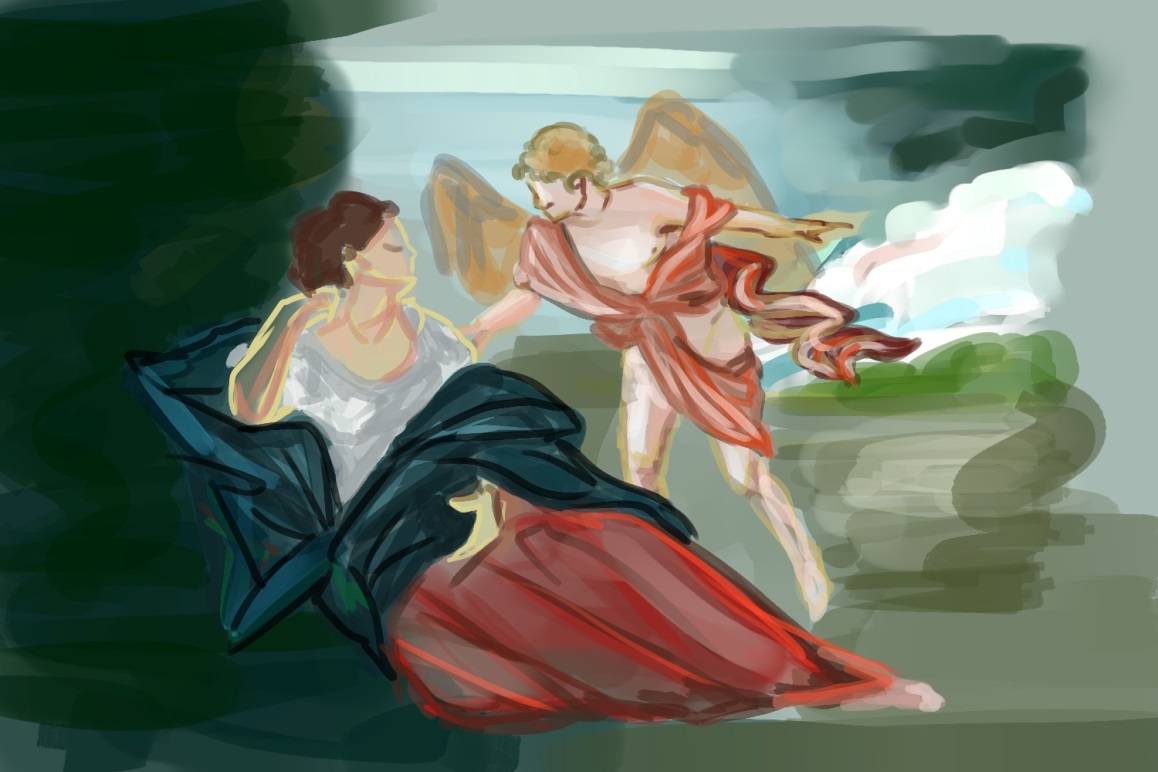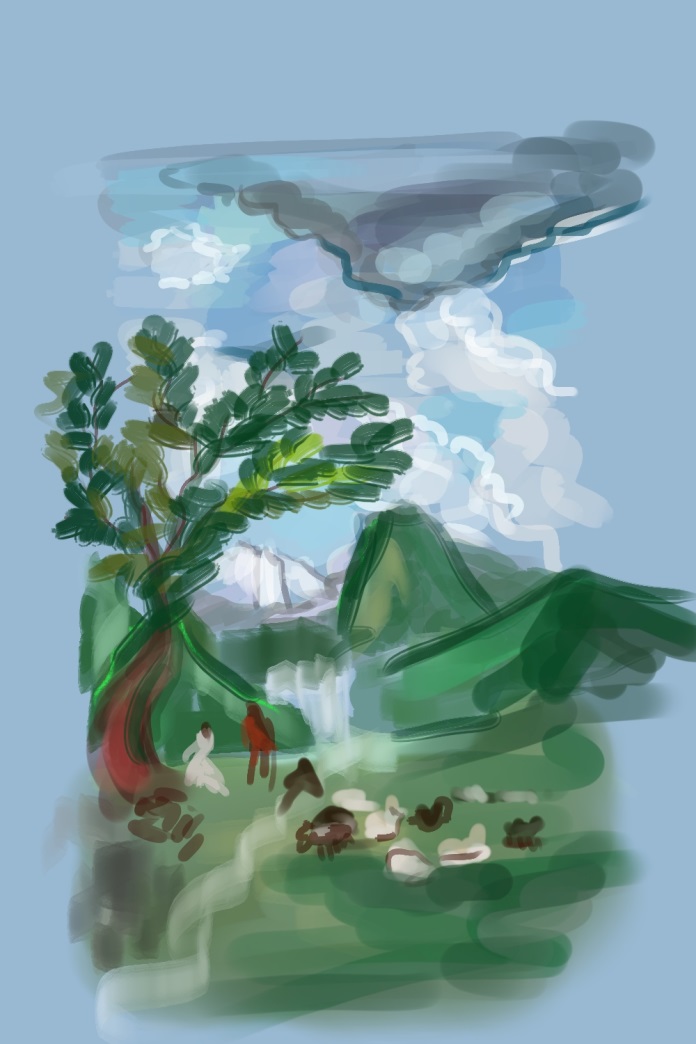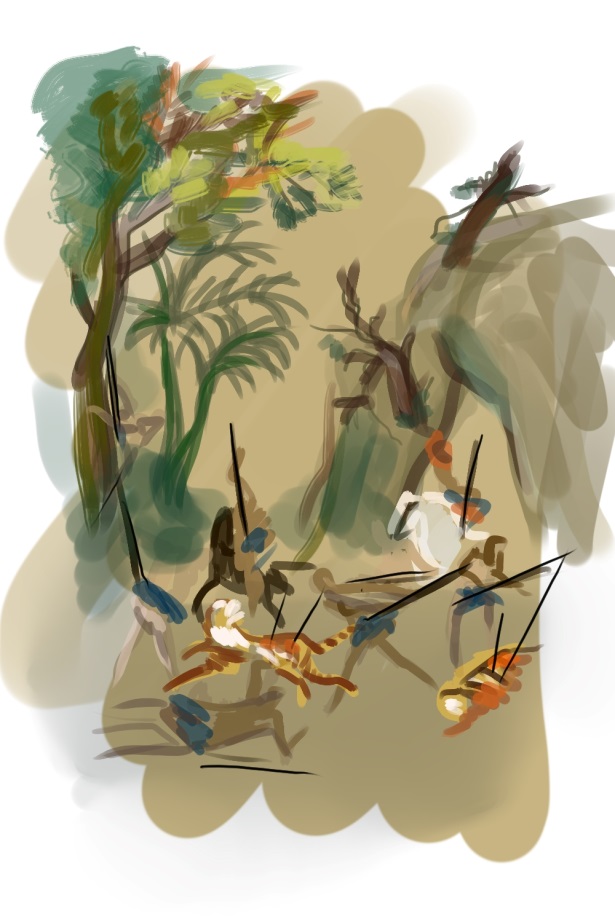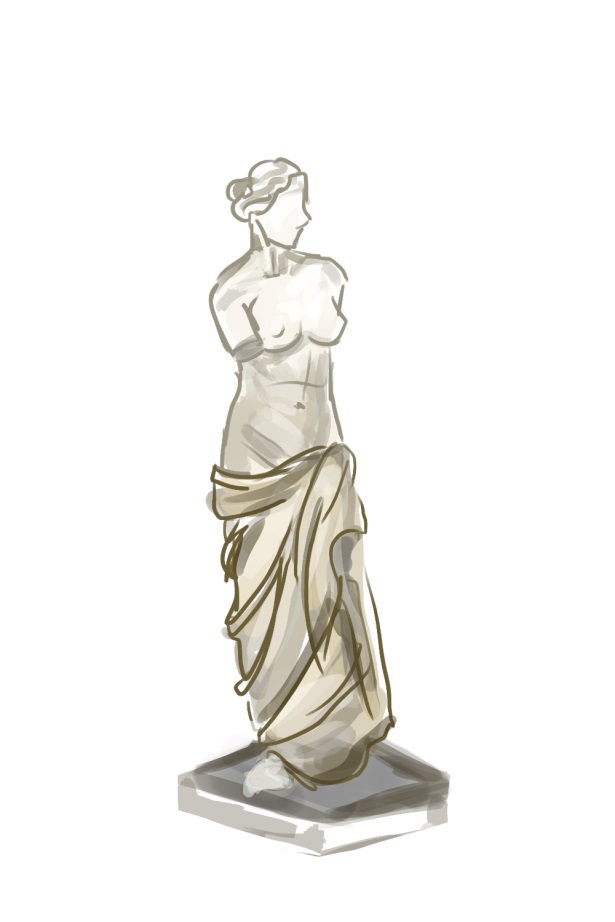Agar secourue par l’ange dans le desert. Lanfranco, Giovanni (first half of XVII century). Religious nature. Louvre. Web.
When you first see the painting, you realize the size and breadth of the field portrayed by the author. The angel is softly touching Hagar’s shoulder and calling her to the water. Hagar’s shoulder and the angel’s soft wing cover Ishmael, Hagar’s son born of Abraham (Connor 75). The rich, wealthy, bright colors of her garment stand out clearly against the broad dark background of the canvas. The dark green garment flows in jagged lines into the darkness of the deep green behind Hagar’s back.
Only a tiny part of the woman’s figure is illuminated, her child seemingly hiding in the shadows behind her shoulders. The angel, on the contrary, symbolizes softness and light: warm flowers, clear, smooth lines of her clothes, soft blond wings, and hair. The canvas embodies the biblical motif of how the angel led the exiled Hagar from Egypt to the well and gave them the beginning of the Ishmaelites (Connor 76). The openness of the angel’s figure and the sincere kindness on his face give hope to the weary Hagar. The painting leaves a warm imprint on the beholder and perhaps also suggests his “way to the water”.
La Bergère des Alpes. Vernet, Claude-Joseph (1761). Nature. Louvre. Web.
The rustle of the leaves, the murmuring of the brook, the voices of sheep chewing the grass, the clouds are driven by the wind – calm on Vernet’s canvas. However, going deeper into history, you learn that this is a tragic scene of a shepherdess mourning her dead husband – a fragment of “Moral Tales” (Marmontel 168). Immediately noticeable is the carelessly piled stones near the grave and its untidiness.
The warm light of the high sun illuminates the people, La Bergere’s tears glisten in its rays as the splashes from the waterfall in the distance. The tall tree is adorned with green foliage, but the trunk itself turns red and black toward the roots, symbolizing the end of the lonely shepherdess’s husband’s life. Her companion expresses sympathy, but his entire flamboyant figure is like a mockery of another’s grief. Vernet uses different techniques in depicting objects of nature; this allows one to feel the depth of the blue sky and the majesty of the mountains. Human misfortunes overshadow the traditional French classical landscapes, but still, the mountains rise above the meadows.
Chasse aux léopards ou Chasse au tigre. Lancret, Nicolas (1736). Violence. Louvre. Web.
Violence is a tool that people regularly use to achieve their goals. No matter how complex society tries, violence also manifests itself in animals: for example, Lancret repeats hunting motifs in his composition of killing tigers (leopards). By the middle of the 17th century, hunting had become an essential part of landscapes, beginning with Rubens (Williams 68). Lancret’s canvas is vivid and sad: the deceptively soft strokes of the trees are mesmerizing, while the straight lines of the hunters’ spears brutally kill the tigers. The foreground is dark, with the white fur of a struggling tiger amid the hunters’ brutal confidence. Another animal dims to the right side of the painting, and a new kill unfolds in the center. Dark figures surround the unfortunate animal, and the imminence of its death is depicted in bleeding wounds. Lancret focuses not on the courage and confidence of the hunters but on the end of the noble animal and its pain.
Vénus de Milo, statue. Unknown author (3rd quarter of the mid-2nd century). Mythology/sculpture. Louvre. Web.
Venus of Milos is a sculpture of the Greek goddess representing love and sincerity (Orgel 59). The woman covers her nakedness and probably feels shame, which brings her closer to the earthly and sinful. It is recognized as a genius by an unknown creator; imperfections include wrong leg lengths, crooked back, and asymmetrical face. All of these irregularities fill the sculpture with human features, emphasizing different facets of nature. The missing parts of the sculpture provoke mystery and mystery, but there is no doubt that this is a piece of art from the Hellenistic period (Orgel 63).
The slight smile on the marble face, the wavy hair in a neat bundle, the soft lines of the belly create an exquisite image of the Greek goddess. The front of the statue is deliberately more beautiful than the back. It means the figure was most meant set in a niche as part of the golden section in the overall architecture. Lost and found a millennium and a half later, the sculpture was always an inspiration. The imperfections of the statue and its relationship to human nature served as the impetus for art.
I came across all of the works except Venus of Milos by chance, but I found grace and some inspiration in each of them. I want to highlight the first painting, the biblical depiction of Hagar’s encounter with an angel. It seems that everyone needs to find their angel –someone to lend a shoulder and help them find the right path. No matter how hard and dark life is, light is bound to appear, and to do so, one only needs to find the strength to take one’s eyes off the ground and lookup. You do not have to believe in God to appreciate the good motives of the painting. But it is important to remember that there will always be good things ahead, and this reminder helps me a lot.
Sketches



